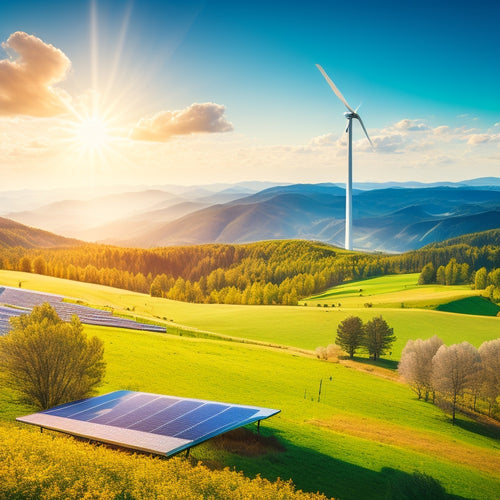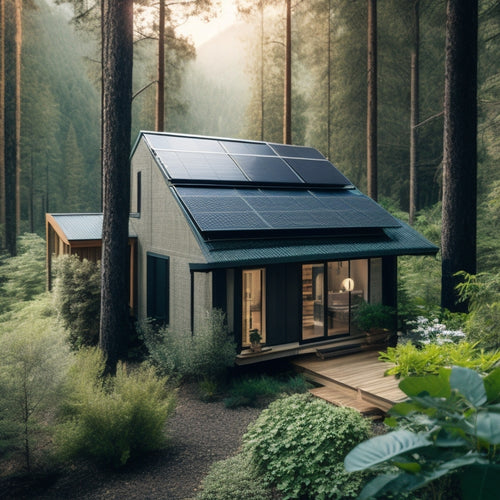
Boost Your Renewable Energy Efficiency Ratings
Share
You're already enhancing your renewable energy systems, but maximizing efficiency requires a deeper investigation into the factors that drive performance, from selecting top-rated solar panel brands to understanding the impact of environmental conditions and maintenance strategies on energy output. Evaluating efficiency ratings is essential for maximizing renewable energy output, and high-efficiency silicon solar cells can achieve conversion rates over 26%. Effective thermal management, ideal panel angle and tilt, and regular maintenance are just a few strategies to increase efficiency, and by exploring the latest innovations in renewable energy technologies, you can access even more opportunities to take your energy efficiency to the next level.
Overview
- Evaluate and upgrade to high-efficiency solar panels, such as monocrystalline cells, to maximize energy output and reduce space requirements.
- Optimize panel angle and tilt to ensure ideal sunlight exposure, adjusting seasonally to compensate for changing sun angles.
- Implement effective thermal management, such as cooling systems, to minimize heat-related efficiency losses in solar panels.
- Regularly clean and maintain solar panels, customizing techniques to environmental factors, to prevent degradation and ensure optimal performance.
- Leverage advanced technologies, including AI and machine learning, to enhance predictive maintenance and optimize energy distribution and consumption.
Understanding Solar Panel Efficiency
Twenty-five years ago, the average solar panel efficiency rating was a mere 10%. Today, you're spoiled for choice with solar panel technology boasting efficiencies of up to 23%.
This extraordinary leap is thanks to solar energy innovations that have altered the industry, with high-efficiency silicon solar cells achieving conversion rates over 26%. Additionally, innovations in thin-film photovoltaics have led to durable and flexible solutions with reduced material consumption.
You now have access to high-performance solar panels that can generate more power per unit area. When selecting a solar panel, you'll want to evaluate the efficiency rating, which is the percentage of sunlight converted into electrical energy.
Higher efficiency ratings translate to more electricity generated, saving you space and increasing your energy independence. As you examine your options, look for panels with high efficiency ratings to maximize your renewable energy output.
Top Rated Solar Panel Brands
With the significance of solar panel efficiency firmly established, you're likely wondering which brands offer the most effective solutions. Top-rated solar panel brands prioritize state-of-the-art solar technology, backed by a strong brand reputation and exceptional installation quality.
They also provide extensive warranty options, staying ahead of market trends and customer reviews. Look for brands that maximize energy yield through product innovation, ensuring a higher return on investment. Supplier reliability is vital, as it directly impacts your system's performance and environmental impact.
Renogy, for instance, is known for its monocrystalline panels with high efficiency rates, making them a popular choice for those seeking high-efficiency solar panels.
Leading brands like SunPower, Panasonic, and Trina Solar have consistently demonstrated their commitment to excellence, making them ideal choices for those seeking freedom from fossil fuels and a cleaner energy future.
Research and compare these top brands to find the best fit for your renewable energy needs.
Comparing Monocrystalline Vs Polycrystalline
When you're evaluating solar panels, you're likely to come across two types: monocrystalline and polycrystalline. The main difference lies in their cell structure, which affects their performance, efficiency, and overall cost.
To guarantee maximum energy production, it's essential to correctly size your solar panel array based on your energy needs and roof characteristics, and consider factors like roof orientation and shading analysis.
Cell Structure Matters
In the pursuit of ideal renewable energy efficiency, the cell structure of solar panels plays an essential role. You need to take into account the cell composition, as it directly affects energy absorption and light interaction.
Monocrystalline and polycrystalline cells differ greatly regarding material quality, manufacturing processes, and surface texture. Monocrystalline cells have a more uniform surface, allowing for better electrical conductivity and reduced degradation factors.
Polycrystalline cells, on the other hand, have a more rugged surface, making them more prone to weather-related issues. When choosing between the two, factor in design innovations that prioritize weather resilience and efficiency.
Efficiency Rate Comparison
Twenty-five years of research have led to a notable gap in efficiency rates between monocrystalline and polycrystalline solar cells. You're likely wondering which type is best for your energy consumption needs. Let's explore the numbers.
| Solar Cell Type | Efficiency Rate | Energy Output |
|---|---|---|
| Monocrystalline | 20-22% | 340-370 W/m² |
| Polycrystalline | 15-18% | 280-310 W/m² |
| Monocrystalline (High-Efficiency) | 24-26% | 410-440 W/m² |
| Polycrystalline (High-Efficiency) | 19-21% | 330-360 W/m² |
When evaluating efficiency metrics, monocrystalline solar cells outperform polycrystalline cells, especially in high-efficiency models. This difference in energy output can greatly impact your renewable energy goals.
Cost and Durability
You're likely evaluating the pros and cons of monocrystalline and polycrystalline solar cells for your renewable energy needs.
When it comes to cost and durability, both options have their advantages. Monocrystalline solar cells have higher installation costs, but they offer longer-term savings due to their higher efficiency rates.
Polycrystalline cells, on the other hand, are more affordable upfront but may require more maintenance expenses over time.
Material durability is an essential factor, with monocrystalline cells typically lasting longer.
Warranty considerations are also important, as a longer warranty can provide peace of mind and protect your investment.
Ultimately, your choice will depend on your budget, energy needs, and performance lifespan expectations.
Effect of Temperature on Efficiency
Your solar panel's efficiency takes a hit when temperatures rise, and this sensitivity to heat can considerably impact its overall performance.
As temperature increases, your panel's ability to convert sunlight into energy decreases. Effective thermal management is essential to mitigate this temperature impact.
You must consider ambient conditions, including seasonal variations, to optimize performance. Heat dissipation techniques, such as cooling systems, can help reduce temperature-related efficiency losses.
By implementing these strategies, you can minimize the negative effects of high temperatures and maximize your renewable energy efficiency ratings.
Boosting Efficiency With Inverters
Optimizing inverter performance is vital to maximizing the energy harvest of your solar panel system.
You'll want to select the right inverter technology and type for your setup, considering factors like inverter placement and system compatibility.
Regular inverter maintenance is essential to guaranteeing peak performance and extending its lifespan.
Smart inverters with efficiency monitoring capabilities can help you track and refine your energy production.
Additionally, look for inverters with advanced power conversion capabilities to guarantee seamless grid integration.
Importance of Panel Angle and Tilt
The panel angle and tilt greatly impact the energy yield of your solar panel system, as they directly influence the amount of sunlight that reaches the photovoltaic cells.
To maximize energy production, you need to guarantee ideal positioning of your panels. This involves adjusting the angle and tilt to match the sun's path throughout the year.
Seasonal adjustments can further enhance energy yield. During the summer, a lower tilt angle allows more sunlight to reach the panels, while a steeper tilt in the winter helps to compensate for the lower sun angle.
Maintaining Peak Performance Over Time
As solar panels operate in various environmental conditions, they inevitably experience degradation, which can greatly impact their performance over time.
To combat this, you'll need to prioritize regular maintenance, including performance monitoring and cleaning techniques customized to your specific environmental factors.
Consider inverter upgrades and system optimization to guarantee maximum energy output.
Energy storage solutions can also help mitigate seasonal adjustments in energy production.
Additionally, be prepared to replace components as needed, taking advantage of technology advancements to minimize downtime.
Frequently Asked Questions
How Do I Ensure My Solar Panels Are Installed Correctly?
To guarantee correct installation, you'll want to verify your solar panels' orientation is optimized for maximum energy capturing, following installation guidelines from manufacturers and local authorities to avoid shading, obstructions, and inefficient energy production.
Can I Use Solar Panels With a Battery Backup System?
As you utilize the power of the ancient Greeks' mythological Helios, you'll find that, yes, you can use solar panels with a battery backup system, leveraging advanced battery storage and seamless solar integration for maximum energy independence.
Do Solar Panels Work Well in Shaded Areas?
You'll find that solar panels' shaded performance is considerably reduced, as even partial shading can decrease solar efficiency by up to 30%; however, you can still generate some power, depending on the type and quality of your panels.
Are Solar Panels Resistant to Extreme Weather Conditions?
Can you really trust your solar panels to withstand the fury of nature? You bet! They're built to last, with solar panel durability and extreme weather resilience in mind, so you can capture the power of the sun, no matter the storm.
Can I Upgrade My Existing Solar Panel System?
You can upgrade your existing solar panel system, but first, you'll need to assess system compatibility and investigate upgrade options, considering factors like panel efficiency, inverter compatibility, and mounting structure integrity to guarantee a seamless integration.
Ready to Buy
As you utilize the power of the sun, remember that every degree of efficiency is a spark that illuminates the path to a sustainable future. By fine-tuning your solar panel system, you're not just maximizing energy output - you're kindling a guiding light of hope for generations to come. With every optimized angle, every precision-crafted inverter, and every carefully selected panel, you're bridging the gap between today's reality and a brighter, renewable tomorrow.
Related Posts
-

Renewable Energy Solutions to Reduce Your Carbon Footprint
To reduce your carbon footprint, adopting renewable energy solutions is key. Using solar panels or wind turbines can ...
-

Essential Hiking Lights for Safety and Fun
When you're hitting the trails, essential hiking lights are vital for safety and fun. A lightweight headlamp offers h...
-

Off Grid Solar Batteries
As you shift to off-grid living, you'll rely on high-performance solar batteries to store excess energy generated by ...


